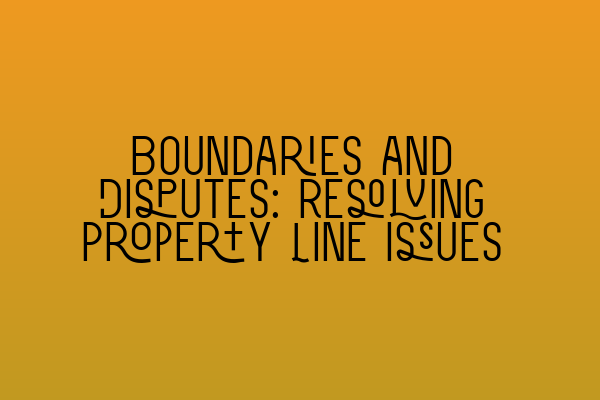Boundaries and Disputes: Resolving Property Line Issues
Having a clear understanding of property boundaries is crucial for property owners and prospective buyers alike. Disputes over property lines can lead to stressful and costly legal battles. In this blog post, we will explore the key elements of boundaries, common causes of disputes, and effective methods for resolving property line issues.
Understanding Boundaries
Boundaries are the legal and physical markers that define the limits of a property. They distinguish one property from another and play a vital role in determining ownership rights and responsibilities. Boundaries can be defined by natural features such as rivers, trees, or fences, or they can be marked by man-made structures such as walls or hedges.
It is essential to differentiate between legal boundaries and physical boundaries. Legal boundaries are determined by official land surveys, property deeds, and other legal documents. Physical boundaries, on the other hand, are the visible markers that help identify the legal boundaries.
Common Causes of Boundary Disputes
Boundary disputes can arise due to various reasons, including:
- Inaccurate or outdated records: In some cases, outdated surveys or incorrect property descriptions can lead to confusion and disputes over boundaries.
- Encroachments: When a neighboring property encroaches on another property, it can lead to conflicts and disputes. This can happen due to construction, landscaping, or other activities.
- Disagreements over boundary lines: Sometimes, neighbors may have different interpretations of where the boundary lines lie, leading to disputes.
Methods for Resolving Boundary Disputes
Resolving boundary disputes can be a complex and sensitive process. Here are some effective methods for resolving property line issues:
- Negotiation: In many cases, disputing parties can resolve their issues through open and constructive communication. Negotiation allows both parties to express their concerns and work towards finding an acceptable solution.
- Mediation: Mediation involves the assistance of a neutral third party who helps facilitate communication and encourages the parties to reach a mutually agreeable resolution. Mediation can be a cost-effective and less adversarial alternative to litigation.
- Arbitration: If negotiation and mediation efforts fail, parties may opt for arbitration. In arbitration, an impartial arbitrator hears both sides and makes a final, binding decision.
- Court Litigation: When all other options have been exhausted, litigation becomes necessary. Property owners can seek resolution through the court system, where a judge will make a binding decision on the dispute.
It is important to note that seeking legal advice from a qualified property law solicitor is highly recommended in boundary dispute cases. An experienced solicitor can guide you through the process, help you understand your rights, and advocate on your behalf.
Conclusion
Resolving property line disputes requires patience, clear communication, and an understanding of legal boundaries. By taking proactive measures and seeking professional guidance when necessary, property owners can mitigate the risks of boundary disputes and protect their investments.
If you’re preparing for the SQE exams or seeking further assistance with legal topics, SQE Property Law & Land Law is here to help. Check out our SQE 1 Practice Exam Questions and SQE 1 Practice Mocks FLK1 FLK2 to enhance your exam preparation. We also offer comprehensive SQE 2 Preparation Courses and SQE 1 Preparation Courses to equip you with the necessary knowledge and skills. Stay updated with the latest SRA SQE Exam Dates to plan your study schedule effectively.
